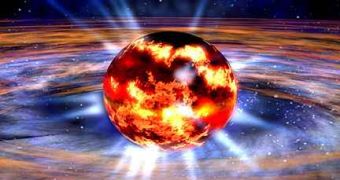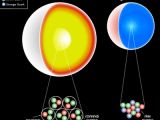One may argue that the comparison between the two distinctive entities is greatly overexaggerated. Indeed, you cannot compare an object that is composed of a handful of particles with the collapsed core of a dead star; however, there are a couple of particles that make the two look alike. Both contain matter in a relative dense state and are always shrouded by some kinds of mysteries that physicists are always trying to reveal.
Neutron stars, as their name point out, are believed to be composed mostly of neutron particles in a free state. Recent observations conducted with the XMM-Newton X-ray space telescope, on three neutron stars located in a globular star cluster that orbits the center of the Milky Way, show that, against general belief, neutron stars are not exclusively composed of neutron particles, but must also contain some sort of other elementary particle, in order to account for their excess mass.
Neutron stars form during the final stages of the life of a star. Stars with masses between 2 to 3 times that of the Sun will most likely suffer a supernova explosion, which compresses the stellar core into objects as small as an asteroid. Before the observations made by the XMM Newton, neutron stars were thought to have diameters similar to that of the Earth; however, the evidence suggests that an object with such a mass could even be 10 to 12 kilometers in diameter.
While calculating the ratio between the mass of an object of just 6 to 8 kilometers radii and its volume, astrophysicists realized that the neutron particles could not alone account for a part of that mass. Thus, it was suggested that they might also contain particles such as pions, kaons or even free quarks.
Detecting such a small object in our galaxy is extremely hard to do, taking into consideration its size, but luckily, most neutron stars emit high levels of X-ray radiation. Statistical calculations of the locations of neutrons stars reveal that they are most likely to be found in the proximity of another regular stars, in a so-called binary system.
Studies of the neutron stars that are located in the Omega Centauri, M31 and NGC 2808 star cluster, may be further analyzed in the near future, by studying X-ray light that is filtered through the thin hydrogen atmosphere surrounding them. Ever since they have been discovered, nearly four decades ago, the radii of the neutron stars have been greatly overestimated, but Natalie Webb and Didier Barret, from Centre d'Etude Spatiale des Rayonnements, Toulouse, France, showed that a neutron star with a mass of 2.4 solar masses could be packed into a compact object only 8 kilometers in radius.
Quarks are currently believed to be responsible for the extra weight, as neutrons that are squeezed even further into a more dense object decay into the constituent particle.

 14 DAY TRIAL //
14 DAY TRIAL // 
